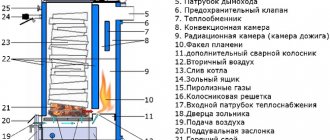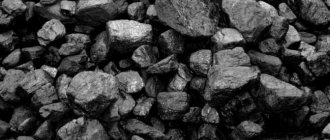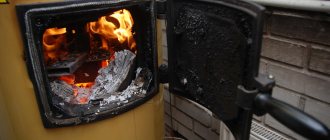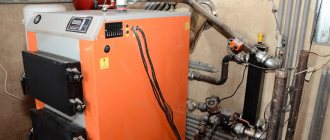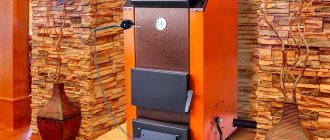Home / Solid fuel boilers
Back
Published: 02/27/2020
Reading time: 5 min
0
4403
Installation of a blower fan on a solid fuel boiler is carried out to optimize combustion processes, which leads to an increase in the efficiency of the thermal circuit and fuel economy.
A fan for a solid fuel boiler can be made independently, which will allow the owner to save significant funds on purchasing a factory-made analogue.
- 1 Purpose of a fan for a boiler
- 2 Design and principle of operation
- 3 Varieties 3.1 Electrically commutated motor
- 3.2 Synchronous motor
- 3.3 Blowers with asynchronous motor
Purpose of a boiler fan
A modern heat supply system involves the installation of an automation unit to regulate the thermal processes of the boiler. It is based on changing the supply of air, which is supplied to the combustion zone by a blower fan and is considered more progressive compared to gravity systems.
The completeness of fuel combustion and the operational productivity of a solid fuel unit largely depend on the volume of supplied air and the size of the draft in the combustion chamber.
The automation unit is equipped with a controller that, according to an established algorithm, regulates the operation of the blower, supplying different volumes of air, thereby supporting the combustion process and, accordingly, the production of a certain amount of thermal energy.
The use of a fan in the boiler control system allows:
Pyrolysis equipment
A pyrolysis type boiler differs from a conventional one in that its design has two combustion chambers: one for fuel, the second for afterburning flammable gases. They are separated by a grate that allows air flow to pass freely. A good material option for this is reinforcement. Under no circumstances should you make a blind partition, otherwise the device will not work.
To make a long-burning pyrolysis-type solid fuel boiler, you will need the following materials and tools:
- Sheet metal 4 mm.
- Pipes with a wall thickness of 2 mm.
- Welding machine.
- Grinders, drills, and accessories for them.
- Metal strips, fittings and corners.
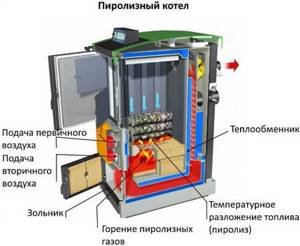
When starting to independently construct such serious equipment, you need to acquire a detailed diagram of the unit. It is advisable that the project be developed by a person with extensive experience in the field of heating engineering. When performing a test run of a homemade long-burning coal boiler, you need to determine its efficiency. The easiest option is to use smoke coming out of the chimney for this. If there is no smell of carbon monoxide, this indicates high efficiency of the equipment. The entire range of operating capacities requires such testing.
Installation of a homemade solid fuel long-burning boiler must be carried out according to all the rules. In this case, it is no longer technical goals that are pursued, but security considerations. Violations result in significant fines, putting people's lives at risk. To install a heating unit, you will need a non-residential premises (boiler room). A brick or concrete base is constructed as a platform for the boiler. The floor in front of the fireboxes is laid with sheet metal 1.5-2 mm thick.
Solid fuel boilers of the new type are significantly different from their previous counterparts. They have a modernized control system, which simplifies the operation of the unit, additional functionality, and an increased number of options.
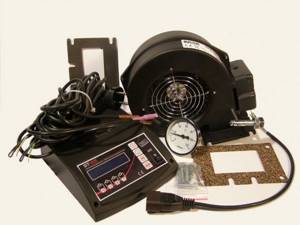
From an ergonomic point of view, setting the required operating parameters is quite beneficial: you perform the action once, and there is no need to periodically adjust it.
The cost of a solid fuel boiler is influenced not only by the availability of high-quality components, but by an improved version of the control unit: the more expensive, the more modern the automation.
The automatic control system is aimed at automating control over the combustion process in a heat generator of this type.
The control unit and fan serve to implement the following tasks:
- maintain the specified temperature of the coolant in the system.
- Provides high efficiency.
- Helps improve efficiency levels.
- They work regardless of fuel quality.
Design and principle of operation
Regardless of the manufacturer, the fan consists of an aluminum or galvanized housing, inside of which there is an electric motor, guide blades and protection in the form of a lattice fence.

This design, despite its simplicity and small dimensions, is reliable. A damper is installed on the supercharger, which is designed to limit the penetration of flue gases into the combustion room in the event of reverse draft.
Also, the damper reduces natural draft when there is no air supply.
The connecting pipes can be located in the upper part of the housing or on the front part of the blowing unit and have various forms of connectors for connection to the boiler.
Algorithm for the functioning of the boiler control system using blown air:
Making a classic model
Building a reliable TT boiler that can last more than 15 years requires the use of the following materials:
- low-carbon steel sheet grade St10-20, 4 mm thick, for the manufacture of a firebox;
- the same, 3 mm thick - for the water jacket and doors;
- metal strip with a cross section of 20 x 3 or 20 x 4 mm;
- a piece of pipe with a diameter of 150 mm for the chimney;
- pipe Ø57 mm with a wall thickness of at least 3.5 mm for the heat exchanger;
- profile pipe 6 x 4 cm for the air duct;
- a corner with a shelf width of 5 cm made of thick metal (4-5 mm) on a grate;
- thin sheet steel with powder painting for external cladding.
Additional materials will require basalt fiber with a density of 80-100 kg/m³ for thermal insulation of the body and asbestos-graphite cord for sealing the door ledges. The automation kit and fan, which were mentioned in the previous section, are made in Poland, model KG Elektronik SP-05. There are also Chinese analogues on the market, they are cheaper.
Step one - welding the body
To weld the fuel chamber, it is necessary to cut 4 mm metal into blanks according to the dimensions indicated in the drawing. Start assembling from the bottom of the ash pan - grab the side walls and lid to it, and then form frames for the loading and cleaning door, as done in the photo.
Then follow this algorithm:
- Weld supports for the grate inside the firebox, and weld clips from a steel strip outside for mounting the water jacket.
- Install and weld the 3mm outer lining sheets of the water jacket. Note that it originates from the top of the ash chamber.
- In the upper compartment, which will subsequently be filled with coolant, cut 4 flame pipes Ø50 mm, and place the same pipes for connection to the heating system.
- Attach legs from pieces of any rolled metal to the unit and install a chimney pipe at the outlet of the fire tube heat exchanger.
Please note that the flame tubes converge in a bundle towards the chimney pipe
Stage two - installation of hanging elements
The doors of the fuel and ash chamber are made by bending the edges of the blanks and welding the internal frame, where the basalt insulation is laid. The insulation is hermetically sealed on top with a lid, and an asbestos-graphite cord is tightly inserted into the resulting groove along the perimeter of the sash.
What else needs to be done:
- Attach the handles and hinges to the body, and cover the doors with heat-resistant enamel.
- Weld a grate from the corners and put it in place.
- Make an air duct with a counter flange and weld it to the rear wall, as shown in the photo.
To insulate and line a homemade TT boiler, it is necessary to weld embedded parts made of any metal at the corners of the water jacket, as long as its width does not exceed 20 mm (on the back wall - 4 cm). Also provide stands for mounting the ECU on the top of the unit.
Final assembly of the heater
Thermal insulation of the boiler tank is simple - the walls are lined on the outside with basalt wool slabs, which are secured with a cord. Make sure that the insulation fits tightly to the frame of the loading and ash opening, as well as to the profile pipe of the air duct.
This is how the control unit and fan are mounted
The last step is to cover the heat generator with polymer-painted metal, screwed with self-tapping screws to previously welded embedded parts. After this, the doors are hung and an automation unit with a fan is installed. An original video from the developer of this long-burning TT boiler, Vitaly Dashko, will help you understand the assembly process:
Varieties
Today, in the retail chain, it is possible to purchase various models of blower fans for solid fuel heating units, both domestic and European assembled.

The most popular options for the location of blowing units are:
The following classification of blowing units is made according to the type of electric motors: asynchronous, electrically commutated EC and synchronous.
Electrically commutated motor
The Electronically Commutated Motor (EC) allows very precise performance adjustments using a pulse width modulation signal.
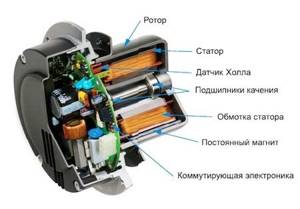
In the case when they are installed on blowing devices, it becomes possible, by changing the speed of rotation of the impeller - impeller, to change the volume of air supplied to the furnace, thereby reducing energy consumption from 50 to 80%.
Despite the high cost of such blowing devices, they are preferable in the installations of modern boiler units, since they are energy-efficient devices, and their use reduces emissions into the environment by reducing thermal energy losses due to underburning of fuel.
EC motors operate in a quiet range and have an extended service life.
Synchronous motor
The blower fan for a boiler with a synchronous motor is characterized by a simple design and a low price. The disadvantages of this model include a limited adjustment range and low torque when starting the engine. As a rule, such blowing devices are installed to supply a constant volume of air into the combustion chamber.
Boilers with fairly large dimensions are equipped with such engines. Basically, such engines are mounted in a separate block.
When operating synchronous motors at low speeds, winding overheating often occurs. In an exhaust type boiler, fans are installed on the chimney; they are also called smoke exhausters.
Blowers with asynchronous motor
Such electric motors have many advantages. They are convenient and easy to maintain and are durable in design. A disadvantage of this type of electric drive is high starting currents.
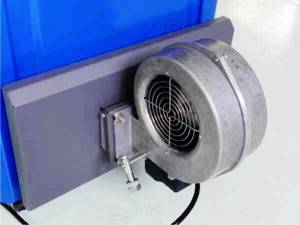
Therefore, it will be necessary to properly arrange the power part in order to put into operation such a device that is sensitive to current parameters.
The asynchronous electric motor makes it possible to easily adjust the speed. Certain modifications also have a reverse mode. The main positive qualities of fans with an asynchronous electric motor:
What is a fireplace exhauster and why is it needed?
This device is a duct fan with an electric motor, which is mounted at the outlet of the chimney. The principle of operation of the device is simple - during operation of the fan, the draft in the chimney increases.
Simply put, this device is a forced exhaust system, but they are not designed for full exhaust. They are used only to improve (occasionally) the natural draft in the pipe, or during its repair.
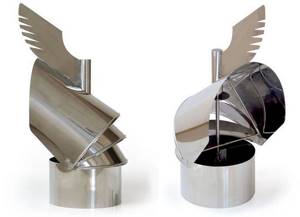
Chimney hoods
For example, a fireplace smoke exhauster is started as needed - for a time when the natural draft drops to a certain value.
When should it be used?
There are several indications for the use of a fireplace smoke exhauster, which are in one way or another related to draft disturbances in the chimney pipe.
Indications for use:
- When there is no draft at all in the chimney pipe (for example, due to errors in the construction of the chimney pipe, or because of its weakness in terms of exhaust). This often happens when the chimney height is selected incorrectly.
- In cases where the chimney is incorrectly positioned relative to the roof ridge.
- If a taller building was built nearby and, accordingly, the draft fell because of this (due to an obstruction to wind flows).
- In cases where the chimney needs repair work (gaps, cracks, or any protruding elements have appeared).
- In cases where the diameter of the chimney chosen is not large enough, or, on the contrary, too large.
Pros and cons of use
Any device of this type has both a number of undeniable advantages and a number of disadvantages. This is also true for smoke exhausters.
Among the advantages of such a device it is worth noting:
- you don’t have to repair the chimney “right now” - the smoke exhauster allows you to postpone repair work indefinitely;
- the ability to create the necessary traction by increasing it, in any weather;
- you can significantly reduce the harm from the formation of condensation due to the fact that the draft will be increased, and as a result, less condensate will form;
- the ability to turn off the fan at any time when there is sufficient natural exhaust from the chimney.
List of disadvantages of using such a device:
- It is not always possible to install a smoke exhauster;
- additional consumption of electrical energy (however, to be fair, such fans consume relatively little electricity).
For which chimneys is it suitable?
The smoke exhauster can be used on chimney pipes for stoves, fireplaces, and various boilers (gas and solid fuel)
But there is one important condition - such a product can only be installed on chimneys in which the temperature does not exceed +600 degrees
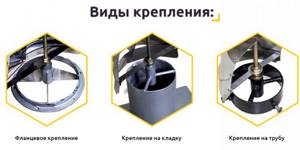
Types of fastening of chimney hoods
This also applies to heat-resistant models. Although they are designed for high-temperature operation, they are not too high (therefore they are used for a stove or fireplace, but not for industrial purposes). Moreover, +600 degrees is a very good indicator; many heat-resistant smoke exhausters are even designed for temperatures up to +350 degrees (average value).
Features of choice
The performance of a boiler unit operating on solid fuel is largely determined by a professionally selected supercharger.
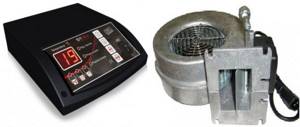
In order to choose the right fan, you need to pay attention to the following parameters:
If the equipment is chosen incorrectly, when the fan for a solid fuel boiler is unable to supply the required volume of air to the furnace, the process of incomplete combustion of the fuel will begin, the efficiency of the boiler will drop, and the temperature regime will not be achieved.
If the blower is installed with high power, it will release a large amount of air into the firebox. The combustion process will be intense, the boiler will quickly reach the required temperature and the control unit controller will give a signal to turn off the fan, thus the blowing device will enter the clocking process, when it will often turn on and off, which will lead to premature wear of the equipment and its failure.
Recommended installation options for WPA fans for ZOT or Carbon boilers, for heating units operating on anthracite:
What is long burning
The specificity of the long-burning principle is that the fuel burns from top to bottom (analogous to a candle), which ensures more complete combustion and increases the burning time of each burn. In some models with a buffer capacity, it can reach almost seven days. This ensures decent efficiency, high and stable water temperature in the boiler, which plays the role of coolant.
To ensure safe and uninterrupted operation, the boilers of the specified system units have smoke exhausters, special fans for solid fuel boilers designed for emergency extinguishing, a circulation pump built into the heating system and safety valves (and accessories for them), as well as control units.
Rice. 2 Centrifugal exhaust fan
All boilers of this type have pre-installed automation, which also includes a fan for a solid fuel boiler. This means they need a source of electricity.
- pellet - these models with a fan are heated with special pellets. The main design elements are the boiler itself, a fuel bunker and an automatic pellet fan supply system. The built-in electronic fan system (control unit) controls the presence and amount of fuel in the firebox (combustion chamber). In the absence of the latter, it supplies pellets from the hopper.
- Pyrolysis equipment components with a fan – otherwise called gas generators. Very economical products with a fan, because In addition to the heat obtained from the combustion of fuel, they use heat from the afterburning of gases generated during the combustion of fuel. At the output, with a minimum consumption of burned material, a maximum of thermal energy is obtained. Hence the increase in efficiency and environmental attractiveness of the design.
Rice.
3 Household smoke extractor In order to understand exactly what components with a fan you may need for a medium or major repair of an installed boiler with a factory-made fan, or for its own manufacture, you need to have an idea of its structure and the principles underlying its operation.
Do it yourself
Modern solid fuel boilers are widely equipped with blower fans, which allows automation of the combustion process.

You can make such a device with your own hands at home. You only need to balance the impeller, the blades of which must have equal weight and configuration.
To produce a homemade fan you will need:
It is much easier to make a blower fan for a boiler by selecting an electric motor with an impeller and an impeller. In this option, you will need to make an iron box, place the engine and impeller in the center and connect the fan to the solid fuel boiler.
READ How to install applications on a memory card on Android from the play market
You can make the impeller yourself using the appropriate drawings. The blades are made from a sheet of metal, then they are lightly tacked by electric welding, they are balanced on the shaft and the quality of rotation is checked.
A professionally made fan should be completely free of blade pulsation.
The automation unit for controlling such a fan consists of the simplest versions of a temperature sensor and a dimmer that reduces or increases the engine speed based on the hot water temperature.
In addition, it is possible to purchase automatic units in the retail network that have advanced logic and are well integrated into the automatic boiler control mode.
You only need to professionally select a fan, whose power must match the characteristics of the heating boiler.
It is possible to make a fan with your own hands in order to ensure complete combustion of fuel and adjustment of the boiler depending on the required temperature conditions.
Source
How to install a smoke exhauster
If you need to install a smoke exhauster on a chimney, which is impossible to remove or disassemble, and it is not possible to install the pump inside the room, then you have to install it outside. Although the best option for an electric motor is indoor installation. Smoke exhausters are usually sold with an impeller, an impeller and an electric motor with mounting for the boiler or for the pipe. You need to choose a suitable smoke exhauster, taking into account:
- Dimensions;
- Power;
- Connection diagram.
When there is a smoke exhauster and a chimney pipe, you need to figure out how to connect it all together. Most often, the engine is attached to an improvised snail. And the snail is welded (attached) directly to the chimney pipe. The connection slot must be equipped with a flap so that it can be opened or closed. Based on specific weather and other conditions - using natural or forced draft.
In principle, there is nothing complicated or supernatural about installing this device, and any home craftsman can handle it. Everything can be done with an ordinary grinder and drill at home. It is advisable to first make a connection drawing, which will indicate the dimensions and diameters of the nozzles and the main pipe. For example, if your chimney pipe is 159 mm, then the outlet from it for the smoke exhauster can be 110 mm in diameter.
Types of traction fans
Today on sale you can find various modifications of traction fans designed for wood-burning fireplaces, solid fuel and gas heating boilers. By choosing the right type of fan, it will be possible to ensure a significant increase in the efficiency of thermal installations.
The most common types of smoke exhausters are:
Surface-mounted smoke exhausters designed for domestic heating boilers have a semicircular platform and screed clamps. Such a fan for a solid fuel boiler is mounted on a vertical section of an uninsulated chimney. Surface-mounted smoke exhausters are efficient and have a simple and reliable design, but it can be difficult to configure such equipment correctly.
Duct fans for solid fuel boilers have their own housing with two mounting pipes and flanges. The unit is installed horizontally or vertically into the chimney pipe gap. The operating principle of such a fan is similar to a boiler hood. The duct type smoke exhauster is most widespread, which is explained by its functionality, ease of operation and the ability to fine-tune the impeller rotation speed. The entire operation of the duct fan can be fully controlled automatically.
Electric hoods for stoves and fireplaces are mounted on the chimney head, secured with spacer bolts. The power supply cable is routed through a pipe and connected directly to the electrical panel or RCD.
When choosing the type and power of a fan, you must proceed from three main criteria:
The basis of the fan for the heating boiler will be the electric motor, which is responsible for the operation of this equipment. Today, there are three main types of electric motors used for superchargers:
The latter option is most often used, since it allows you to quickly change the speed of the impeller and thereby regulate the operation of the fan. However, with such a drive, certain difficulties arise with the choice of temperature controllers. Another disadvantage of fans with an electrically commutated motor is their high cost.
Fans with synchronous motors are simple in design and have an affordable price. The disadvantages of this type of equipment include limited adjustment options and low torque when starting the engine.
The asynchronous motor has numerous advantages. It is convenient and easy to use, and has a reliable design. The disadvantages of this type of drive include high starting currents. Accordingly, it is necessary to properly organize the power part, which will allow such equipment, which is demanding in terms of voltage parameters, to be put into operation.
Uninterruptible power supplies (UPS)
The UPS (uninterruptible power supply) source for equipment operating on solid fuel, otherwise called an uninterruptible power supply, is selected taking into account the total electrical power required for it.
In the simplest version, when the version of the installed boiler has manual fuel loading, the supply of oxygen to the combustion site is regulated by mechanical rotation of the ash door, and the system operates due to the temperature difference between the supply and return coolant, only the energy consumption of the circulation pump will be considered. In this case, the power of an uninterruptible power supply for a solid fuel boiler is calculated taking into account the number of pumps, their power, the probability of simultaneous activation, etc.
This is the first component of the assessment. The second is due to the fact that in the event of a possible long-term loss of power from the external network, an uninterruptible power supply for a solid fuel boiler (UPS) must be guaranteed to ensure the operation of the boiler throughout the entire outage period, which can be several hours.
Taking into account all of the above, the following models are considered the most acceptable for solid fuel boilers:
- line-interactive uninterruptible power supply (for example, INELT Intelligent 500LT2) with one or two batteries;
- uninterruptible power supply with double conversion (type East EA910 LCDH).
Automation for solid fuel boilers: combustion control principle
At first glance, it may seem that controlling the element of fire (even placed in a confined space) is very difficult, but in fact this is not the case. Remember what affects the combustion intensity of solid fuel - that’s it, oxygen, which is supplied to the boiler through the ash pan. Consequently, you can control the operation of the boiler by opening and closing the vent - yes, this is not very convenient and not very practical, but who says that you can’t come up with an alternative? It’s very possible - all you need to do is install an electric fan in the vent door. And people can control its rotation speed very effectively.
Thus, modern automation for a solid fuel boiler fan has the following form.
The required coolant temperature is set on the controller - when the water in the system heats up to the set point, the sensor is triggered and the automation turns off the fan. Oxygen stops flowing into the boiler firebox, causing the fire to die out. And, conversely, as soon as the coolant temperature drops below a certain value, the same sensor sends a signal to the controller, which starts the fan - an abundant amount of air in the firebox ignites the flame with renewed vigor. Everything is simple, and the most important thing is that the person will not forget to cover the vent, thereby bringing the boiler to a boil.
Construction of a solid fuel boiler
Firebox
This is the main element of any component equipment, performing a dual function: a heat exchanger and a combustion chamber.
Detailing its design, it should be noted that the product has:
- a smoke exhaust hole that provides air access to the combustion site;
- ash pan;
- grate;
- dome upper part of the smoke exhauster (for collecting and subsequent removal of gases and combustion products that are in the volatile stage);
- portal through which fuel is supplied.
Burning in the furnace, solid fuel heats the walls of the equipment with a fan and heats the water, which is located in the water jacket of the boiler with a buffer tank, to a high temperature. For better performance, it is often equipped with a smoke exhauster.
Water jacket
Rice.
4 Automation for solid fuel boilers In almost all models of solid fuel equipment with a fan, the jacket is located between the double walls of the firebox. Acting as a coolant, water (in the vast majority of cases), passing through the jacket, takes heat from the firebox, thereby protecting it from overheating, and carries it into the heating system. Hot water leaves the jacket through the pipes in its upper part, and the cooled water in the system enters the jacket through the lower pipes.
Solid fuel equipment with a fan is capable of operating when the coolant moves through the heating system lines by gravity (so-called open systems). Although it is technically possible to equip boilers with circulation units and pumps of varying power and performance (in this case, you always need to have the necessary components for them). The presence of system blocks significantly increases the heat transfer of the unit.
Despite this, open systems with a fan are in high demand, as they are independent of external power sources, economical and very reliable. Equipment with a buffer tank equipped with a fan, used not only for heating the room, but also for providing consumers with hot water, have boilers connected to them and are necessarily equipped with a control unit.
Gas removal system
Rice.
5 Automation kit for a solid fuel boiler Inside a boiler with a fan, during the combustion of fuel, a lot of smoke is generated. Therefore, if you do not provide it with a properly working smoke exhauster, all this will end up inside the room. As a rule, the role of a chimney is performed by thermally insulated pipes that remove combustion products outside the building. Smoke exhausters and/or a fan for a solid fuel boiler are often installed here.
Temperature regulation and control unit system
A constant supply of fresh air to the combustion site by a smoke exhauster is a necessary condition for any combustion process. The greater the air flow, the more intense combustion can be achieved.
That is why the design of any solid fuel equipment must have mechanical dampers and dampers used to regulate the air supply (and components for their prompt repair and replacement). Smoke exhausters are often installed.
Rice. 6 UPS for solid fuel boiler
Control unit systems based on the use of such control methods are simple and very reliable. The smoke exhaust damper is specially fixed to the regulator. When the set temperature is significantly exceeded, the walls of the regulator expand, which leads to the lowering of the damper (the flow area of the supply air duct decreases), which helps cool the firebox and protects it from overheating.
During the reverse process, the walls of the regulator are correspondingly compressed and initiate the rise of the damper. The intensity of combustion increases again.
Despite the very venerable age of this technical solution, it remains one of the most effective and efficient to this day. That is why it is implemented in the vast majority of models of solid fuel boilers. Although new models often have special systems and a control unit for them.
Advantages provided by an automation kit for a solid fuel boiler
There are no accidents or coincidences in our world, and people had to automate the process of burning solid fuel in a heating boiler for a reason - there are a number of good reasons for this. The most important of them is safety. Anyone who uses solid fuel to heat a home probably knows the consequences of overheating the coolant - boiling water in the boiler can even lead to an explosion with serious consequences. First of all, automatic control allows you to control exactly this moment - a person is a forgetful creature by nature, and automation works according to a program, and there is no such thing as “forgetting” for it.
In addition, automation of a solid fuel boiler provides a number of other benefits to humans.
This concerns the primary tasks that automation for a solid fuel boiler is designed to solve. In addition to them, depending on its complexity, automatic control of fuel combustion may have additional options that expand the capabilities.
What components and assemblies may be required when making a boiler yourself or repairing it?
Components for solid fuel boilers have varying degrees of demand. Some are guaranteed to last until the boiler is written off. The latter have a certain resource. It is the latter that will be discussed below.
First of all, it is necessary to ensure guaranteed protection of the solid fuel boiler from overheating. In this case, it is necessary to take into account the inertia of fuel combustion inherent in solid fuel boilers, the presence of which excludes the possibility of safely stopping the entire control unit system until the fuel is completely burned out. You cannot stop the combustion process of wood or coal, you can only reduce the intensity of combustion. This is what determines the need for mandatory protection against possible overheating.
Protection of a solid fuel boiler from overheating is carried out by using the following technical solutions:
a. cooling heat exchanger
Through an installed thermal valve, which is a control element, cold coolant is supplied to this product, which does not lose its functionality up to almost 95 degrees above zero. When the equipment warms up to a predetermined limit temperature, the thermal valve is activated and the coolant is redirected to the heat exchanger, where it is quickly cooled by a fan to the permitted level. The cycle is repeated until the water temperature drops to +60 degrees.

Rice. 7 UPS for boilers
The heat exchanger can be structurally built into the boiler, or mounted between the heating system and the outlet of the water heater. The use of this method initially provides for the availability of an irreducible required supply of cold coolant. In the event of an emergency shutdown of a unit without such a protection system, it may fail due to overheating. That is why it is very important to ensure the quality of all components.
b. switching valve
The shut-off (also known as switching) valve (control element) is used to cut off (block) the water supply when the boiler overheats. As soon as the temperature of the coolant in the system exceeds the permitted temperature, it is drained into the sewer. At the same time, cold tap water is supplied to the boiler. In order for it to be guaranteed to enter the supply pipeline system, it must be supplied under a certain pressure (up to 3 bar).
Inlet filters reduce the likelihood of scale formation on boiler parts, thereby ensuring its protection. Since they clog quite often, it is necessary to have replacement inserts that come with them. The specified technical solution is one of the possible options for protecting a solid fuel boiler from overheating.
c. Buffer capacity
Buffer tanks for solid fuel boilers simultaneously perform a number of tasks: they accumulate heat coming from the heat generator and, as necessary, release it into the supply lines of the heating system. By receiving superheated water (another coolant) and ensuring its mixing with the warm coolant, the buffer tank provides additional protection of the entire system from overheating.
Thanks to it, the temperature regime improves, and this leads to an increase in the efficiency of the boiler itself, reduces the required amount of fuel and increases the burning time of one load. The buffer tank can also be used as a boiler to supply hot water to other consumers (if there is an appropriate built-in tank). A boiler for a solid fuel boiler requires the installation of a protective thermal valve at the outlet of this tank, because in it the water can be heated to temperatures exceeding +85 degrees.
Automation scheme for solid fuel boilers: expanding possibilities
Man has learned best to control electricity - it is electrical signals and impulses that are used to control everything that is needed, including other equipment involved in the operation of the heating system.
READ How to install night sight on SKS
And that’s not all - modern automation for a solid fuel boiler can do many different things. For example, it allows you to program it, so to speak, remotely, using a GSM module. It is also possible to program the heating operation daily, daily and even hourly. By and large, correctly selected automation for a solid fuel boiler even makes it possible to integrate it into a global smart home system.
Combined boilers for summer cottages
Boilers for summer cottages can heat up to two hundred and fifty square meters; they use solid fuel: firewood, briquettes, coal and electricity.
Combination boilers are made of metal, the body thickness of which is usually three centimeters. The boilers are painted with white powder paint, suitable for a summer residence. They work on wood. Power three, or 6 kilowatts. Easy to control - via the Remote Control. The remote control regulates the room temperature remotely. Boilers for summer cottages are easy to install, and their weight is up to 110 kilograms. The chimney is made with adapters. Do not forget to make a concrete foundation of about 100 mm. Cover the foundation with 2-3 mm sheet iron to protect the flooring.
All boilers that operate on solid fuel for heating a dacha have a damper for the chimney, a tray for collecting ash and are equipped with a poker. The firewood door is made of three metal layers, so the door does not get hot. The solid fuel boiler for the dacha is equipped with cast iron and a burner. And the modified ones even have 2 burners, which is very convenient if the boiler is in the kitchen.
Such boilers are very easy to use: they are equipped with a water jacket on four sides, which protects you from the danger of getting burned, since the temperature can be above 85 degrees. This safe device can be installed even in a room or living room.
Attractive appearance, affordable price and ease of installation - these are perhaps the most important advantages of such boilers.
Thus, the above types of heating are perfect for any dacha - the only question is the capabilities and needs of the owner of the house, because everything depends on this.
Subscribe to our newsletter for new materials:
How to make simple automation with your own hands: tips and tricks
It’s not difficult to set up the simplest automatic control of a solid fuel boiler with your own hands. The most important thing here is to buy the right equipment. You understand that you will not be able to make all the necessary devices, and the equipment itself, by and large, does not cost that much. That is why, when talking about homemade automation for a solid fuel boiler, in most cases we mean buying ready-made equipment and installing it yourself. Do-it-yourself installation is quite simple, and you can imagine this whole process in the form of the following sequence of work.
When the automation is assembled, there is only one thing left to do - install a temperature sensor. As a rule, in almost all models of modern solid fuel boilers a special place is provided for it. If this is not available, then you can attach the sensor directly to the supply pipeline - in the simplest version, this is done using metallized heat-resistant tape. The sensor is simply wound onto the pipe.
This concerns the electronic control of a solid fuel boiler. But besides this, there are also mechanical systems that regulate the intensity of fuel combustion by simply opening and closing the boiler ash door. How such automatic control works is, one might say, quite simple. A mechanical thermoelement is installed in the boiler (in a specially designated place) - when heated, the plate built into it changes its shape and configuration, which sets a special lever in motion. In turn, this lever is connected to the ash door by a cable or chain, which transmits the movement of the lever directly to the door, as a result of which it opens and closes, depending on the temperature of the coolant in the boiler.
Which automation is better for solid fuel boilers? Mechanical or electronic? Both principles of controlling fuel combustion in a boiler have their drawbacks. Electronic systems do not work without electricity - in order to ensure the operation of the boiler during power outages, you will additionally have to purchase an uninterruptible power supply unit. The mechanics often jam. In addition, the choice of one or another automation system for a solid fuel boiler can also be influenced by its cost - mechanics will cost less.
Author of the article Alexander Kulikov
Device
The smoke exhauster is a simple device in terms of design. It consists of several nodes, each of which has its own purpose.
- Frame.
- Suction pipe or suction pocket of the smoke exhauster.
- Guide apparatus. There is right and left rotation, which is determined by the direction of the fan blades.
- Working wheel.
- Frame.
- Electric motor.
The body is made in the form of a “snail”, which provides the required swirl of air entering the unit. Made of heat-resistant steel, covered with thermal insulation.
The guide apparatus of the smoke exhauster is located on the suction pipe and allows air pressure to be regulated using a rotating mechanism that combines the fan blades. Each blade is curved, which allows the air flow to rotate in the same direction in which the rotor rotates. Using a rotating mechanism, you can block the lumen of the pipe to one degree or another.
The smoke exhauster impeller is the unit on which the fan blades are located. They are attached to it by welding or rivets. A rarefied atmosphere is created in the central part of the wheel as it rotates. For this reason, incoming air is drawn in here. Small-sized devices such as smoke exhausters for fireplaces work in a similar way.
The wheel docking unit can be located on the motor shaft or intermediate shaft, depending on the design of the unit. If this is dust collection equipment, the device includes special filters with absorbents. All fire-fighting units are equipped in this way. Ash collectors can be included in the design of boiler room equipment. The design of the smoke exhauster determines its purpose.
The impeller may have holes necessary to fix the blades in a given position. Balancing can be done manually or by an electrical actuator. You can distinguish the direction of rotation of the fan blades if you look at the unit from the side of its electric motor. The axial guide apparatus of the smoke exhauster ensures rotation of the blades, regardless of their number and direction of slope, at an angle from 0 to 90°.
A blower fan and a smoke exhauster have a similar design, but differ in purpose. Devices of the first type provide air injection into the boiler furnace. The latter are designed to remove fuel combustion products and release them into the atmosphere outside the boiler room.
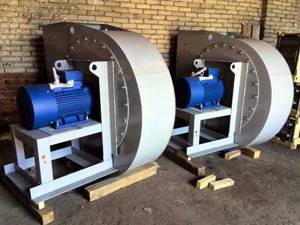
Fans and smoke exhausters of boiler installations have the same operating principle; they can be left- or right-handed, with forward and reverse draft. These machines are designed for long-term trouble-free operation in a temperature range from 0 °C to +250 °C. Smoke exhausters are marked as “D” and “DN”, fans - as “VDN”. The latter are produced with the impeller mounted on the electric motor shaft.
Repair of smoke exhausters and fans is carried out by persons who have undergone appropriate certification and instruction in the safety precautions for operating electrical appliances.
Why do you need a fan? Its main functions
A solid fuel boiler in the usual sense is a heating device, where the main work is carried out by burning fuel. In the presence of draft and natural air flow, the combustion intensity is weak, and heat transfer is correspondingly low. An example is a fireplace. The natural flow of air does not allow the flame to flare up strongly in the firebox, so this heating device has limited technological capabilities.
It's a completely different matter when the supercharger comes into play. An additional volume of air is pumped into the furnace of the heating device. The combustion becomes intense, the fuel burns out completely, releasing the maximum amount of kilocalories.
Therefore, for modern models of solid fuel boilers, of almost all types and types, the fan is one of the most important elements of the control system. Typically, the automation kit for heating devices today includes a blower, a smoke exhauster and a control unit. Competent and correct installation of such devices and devices on boiler equipment will ensure reliable and balanced operation of your unit.
Note: the combustion process is 90% dependent on the operation of the supercharger. Thanks to the action of this device, air is pumped into the combustion chamber, the combustion intensity increases, and the efficiency of the heating equipment increases accordingly.
Today, domestic and foreign industry produces a huge number of household fans (coolers), specially designed for installation on heating devices. When choosing a supercharger for your unit, you need to focus on the power of the boiler and your own household needs. A solid fuel unit with a fan is a high-tech and efficient heating machine. All processes, from flue gas extraction to better combustion chamber performance, depend on the operation of fans.
In other words: there are exhaust fans installed in the chimney and blowing devices specifically designed to pump air into the firebox of the heating device. Typically, an air blower is used when working with fuel that is difficult to ignite. Coke, coal or wet wood do not burn well at first. Therefore, for better combustion in this situation, a pressurization device is used. Other types of fuel, such as pellets, briquettes and dry firewood, require constant air supply. By installing fans on the boiler, you will be able to achieve economical fuel consumption for a solid fuel boiler, and the safety of boiler equipment will significantly increase. There is no more reason to worry about the quality of combustion in the firebox or worry about the operation of the hood.
What is better: a smoke exhauster or a blower?
When the traction turbine is integrated into the heat generator by the manufacturer, such questions do not arise. Adding an exhaust fan to a conventional direct combustion boiler is another matter. You must understand that in this case the smoke exhauster solves only one problem - creating a vacuum in the firebox and increasing draft. There are a number of negative points here:
- Without an electronic control unit, performance will have to be adjusted manually. Automatic maintenance of coolant temperature is excluded.
- When air is supplied through the open ash chamber door, the fan will force the boiler to operate at maximum. Setting up a long burn mode will not be easy.
- In the event of an emergency stop of the impeller, fuel combustion will not stop, since gases pass freely through the volute or the body of the smoke exhauster. Air enters the firebox, increasing the likelihood of overheating.
- The impeller and internal surfaces of the unit become covered with soot, which must be removed. The rate of sticking depends on the moisture content and resin content of the wood.
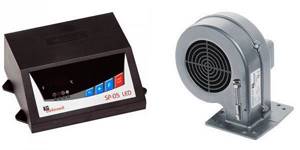
Blowing machines always work in conjunction with a controller, so the problems listed above do not exist:
- the blower changes performance and turns off at the command of the control unit, the coolant heats up to the set temperature;
- during the combustion process, the ash pan door is hermetically closed, air is supplied through a separate channel;
- when there is a power outage, the air channel is automatically closed by a gravity damper;
- the impeller blades do not come into contact with hot smoke and soot.
Now let’s compare the cost of a traction fan and a blower fan, not taking into account the price of the controller. A smoke exhauster for a TT boiler up to 30 kW will cost 90 USD. e., supercharger - 60-65 cu. e. The difference is due to the design features of the exhaust unit - hot gases should not overheat the electric motor, plus the impeller is made of metal (when pressurized, it is made of plastic).
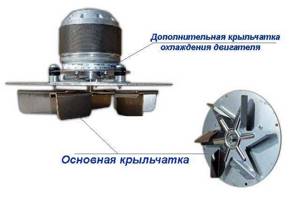
The installation complexity of the units is approximately the same. Installation of the discharge volute involves cutting out an opening in the ash pan door, and the smoke exhauster involves disassembling or cutting out the pipe. It is easier to install a roof hood, but you will have to pull a long cable.
Device structure and types of fans
According to their functional characteristics and parameters, fans are divided into three types, each of which is determined by the design of the engine. The electric motors used for these purposes can operate on both alternating and direct current. The advent of electronic equipment created the prerequisites for the active use of AC motors. Unlike DC motors, AC electric motors have virtually no disadvantages. The simple and unpretentious design of electric motors has made it possible to establish mass production of a wide variety of electromechanical devices. Most fans are equipped with just such electric motors.
Today on the market you can find the following types of fans:
All products have their obvious advantages and disadvantages. In the case of an electrically commutated motor, we can talk about one quality. The device itself is capable of changing the speed, receiving the corresponding signal from the control unit. Here we can talk about a wide range of fan operation adjustments. However, the device has a significant drawback - the device is not compatible with most domestic temperature controllers. In addition, this equipment is expensive.
READ How to install Word on your desktop
Speaking about fans with synchronous electric motors, we can focus on the following: the devices are quite cheap and easy to manufacture. However, this type of equipment has certain disadvantages. Such devices have minimal torque during start-up and a small range of speed adjustment.
For reference: usually fans with synchronous motors are installed to constantly pump air mass into the combustion chamber. The synchronous motors with which the devices are equipped have fairly large dimensions. Typically the supercharger motor is located in a separate unit. When operating at low speeds for synchronous motors, winding overheating is common.
As for the rotation speed range, the values here are not great. On some models the range is adjustable from 30-70%, and from 90 to 100%. This feature is characteristic of a synchronous motor. According to experts, it is not recommended to equip household solid fuel boilers with fans with synchronous electric motors. Microprocessor temperature controllers are poorly compatible with a device in which the number of revolutions is limited and the power is within strict limits.
The last, third type of fans used in modern heating systems has a number of advantages. The asynchronous electric motor allows you to easily regulate the number of revolutions. On some models there is even a reverse. The main advantages of such a device are as follows:
The only drawback that is typical of asynchronous motors is high starting currents.
Classification of boilers operating on solid fuel
The market today offers the widest selection of models with a buffer capacity, solid fuel boilers, both domestic and foreign. Components for solid fuel boilers are also widely represented. They can be used both to work only on the heating system, and to heat the boiler for domestic needs.
The equipment is divided into:
- according to the material from which they are made: steel - products are much cheaper than cast iron boilers, easier to clean and maintain. But they are very sensitive to the temperature in the return circuit (not lower than 60 degrees). Therefore, they require the installation of a block of special boiler valves, which are a kind of control element and maintain the required temperature value in it by mixing coolant from the supply line into the “backflow”;
- cast iron - more durable, but more difficult to maintain. Recommended only for continuous year-round use. Not acceptable as a backup, too expensive;
- peat, firewood, wood waste, derivatives thereof, supplied in special briquettes;
- water boiler (most commonly used);
- traditional way;
Types of smoke exhausters for boilers
To increase the efficiency of the hood, you can make the chimney longer or install a deflector at its end. Sometimes this measure helps to avoid the use of electromechanical devices. But when all options have been exhausted and the problem is not solved, you can use the following devices:
In powerful heating systems, a draft-blowing circuit using two synchronized fans can be used. This will require synchronizing the operation of the hood with the operation of the boiler.
How to install an electric blower for a boiler
Electric blower for a wood-burning boiler works in combination with an automation system or, as it is called, a control unit. It is this unit that will control fuel combustion and the set temperature regime.
As for the electric blower itself, it is installed according to the following steps:
- Fix the fan on the pipe that supplies air to the boiler;
- Connect by blowing to the control unit;
- Connect all devices to the network;
- Adjust the blowing parameters according to your needs and the temperature regime of the coolant in the system;
- Place the firewood in the chamber so that it lies as tightly as possible;
- Light the fuel and place an air supply unit with a fan installed on top.
- Wait about 5 minutes and start blowing.
As soon as the system reaches the temperature that you set, the control unit will automatically turn off the blower. After this, the whole process will be repeated again.
Features of using smoke exhausters
When choosing a traction smoke exhauster, you need to calculate the cross-section of the exhaust pipe and the power of the exhaust unit. Unlike pressure units, they are more versatile and efficient, they allow you to add firewood while the boiler is operating, and prevent combustion products from entering the room.
The use of smoke exhausters for pellet burners or boilers running on sawdust or peat is the only possible way to organize the heating process. Under normal conditions they burn poorly.
Advantages of using a chimney hood:
They have practically no disadvantages. If no errors were made during installation, the service life of the smoke exhauster in the chimney is comparable to the service life of the boiler itself. In this case, regular maintenance must be carried out.
Is it worth designing a gas boiler yourself?
Let’s begin our analysis of options for making a gas boiler with our own hands with the fact that the fuel they process is classified as toxic and explosive substances. Gas is highly flammable. The slightest miscalculations in the design and implementation of homemade products can result in serious destruction, damage to health, and loss of property.
Therefore, we do not recommend developing a model of a gas boiler for people who do not have a technical education with a specialization in the design of gas equipment. Yes, often even experienced gas workers will not take on such a project.
The optimal solution is quite reasonably considered to be:
- Converting a solid fuel model into a gas boiler by installing a gas burner in the firebox;
- Improvement of an old but functional unit with a focus on use in a heating circuit. Supplementing the factory model with devices for heating and stimulating the movement of coolant;
- Manufacturing of a pyrolysis boiler - equipment that generates gaseous fuel as a result of processing solid fuel at the initial stage. At the secondary stage, the gas released during the combustion of wood is burned in an additional firebox.
If you still have a desire to thoroughly study the issue and invent a version of a homemade gas boiler for autonomous heating in a private house, get ready for a literal “walk through agony.” You will have to obtain permits and confirmation of the safety of the invention from a number of government supervisory authorities.
An independent craftsman will need:
- Check the boiler for compliance with safety requirements, and then obtain a confirming or refuting document.
- Obtain permits from GosTechNadzor, Fire Inspectorate of the Ministry of Emergency Situations and GorGaz.
- Apply for a patent and a certificate allowing one-time or continuous production.
This list, although not numerous, is quite impressive and can discourage any folk from inventing documents. However, it will not be able to quell the desire to modernize an existing unit by installing factory-assembled burner modules. The improvement easily combines operational safety with increased efficiency.
The most important working part in gas equipment is the burner. Installing it will turn any boiler into the type of coolant and hot water heater we require for sanitary purposes.

The ignited igniter heats the working part of the thermocouple, which eventually begins to generate current. The charge enters the gas valve coil, it acts as an electromagnet and magnetizes the washer, which closes the path of gas
Depending on the method of supplying the combustion air required for combustion to the combustion chamber, burners are divided into two main groups:
- Atmospheric. They are installed in open combustion chambers of atmospheric boilers. In them, air is drawn freely from the room in which the boiler is located.
- Fan (also known as blower). Such models are equipped with closed combustion chambers into which air is forced in a forced manner and captured from the street. To remove flue gases, they require a coaxial chimney and a fan.
Blowing designs are too complex for home creativity. They are easier and more profitable to buy. After all, purchasing all the adjustment and safety devices for operating a fan burner can be more expensive than purchasing a module ready for installation.
It is also advisable to purchase an atmospheric burner, but you can make the simplest version with your own hands. Below we will consider how and from what it can be assembled.
Technical characteristics and calculation of parameters
The design of any smoke exhauster for household solid fuel boilers looks something like this:
The smoke exhauster for a solid fuel boiler has the following parameters:
All these characteristics can be found in the instruction manual for a specific model.
To correctly calculate the hood, we will also need to know the fuel consumption per hour, the cross-section of the gas-air duct channels and the amount of air for its complete combustion. The following indicators are calculated using formulas:
This data can be obtained from reference books or SNiP, as well as catalogs of equipment sold.
Good draft is the result of correct calculation and installation of the chimney
When asked which chimney is better for a coal boiler, and which for a diesel boiler, etc., the correct answer will always be different. Because a chimney made for a wood-burning stove may be completely unsuitable for a gas boiler, for example. And there may be several reasons for this. At the same time, few people are able to install a new capital chimney to replace an ineffective one. That is why existing chimney pipes have to be improved in one way or another. Often, an improvement involves installing a smoke exhauster for a new domestic boiler.
Everywhere the chimney for a solid fuel boiler is made of solid brick. If it has sufficient height and cross-section, then it always has excellent traction and no air movement amplifiers are required. But there are also exceptions. For example, a brick chimney for a stationary solid fuel boiler cannot be brought to the required height. As a rule, a chimney for a solid fuel boiler is simply made by hand, but it does not always cope with its function perfectly. And it often happens that additional draft needs to be provided using smoke exhausters for household solid fuel boilers, purchased or made by yourself.
What and how to lay out a chimney so that it effectively copes with smoke removal is the topic of a separate large article, and now we will not touch on it. A solid brick chimney is good for a solid fuel boiler or stove, but without additional inserts it cannot be used for modern boilers using other types of fuel. For example, a smoke exhauster for a boiler may be needed if the chimney installation was done incorrectly from the very beginning.
How to properly make a connection to the chimney for a conventional solid fuel boiler? Highly qualified specialists know about this, but they are also mistaken, not noticing some local detail in time. A good smoke exhauster for a solid fuel boiler or any other can eliminate all errors in the design and construction of boilers and chimneys. Especially if the chimney for the boiler is not brick, but metal.
This is a whole science - installing a chimney for a solid fuel boiler. What can we say about more complex options for heating devices. Therefore, errors occur quite often; even simple brick laying is rarely ideal. Compliance with all technical standards for aerodynamics is another task! How to make a chimney if a brick boiler is connected to it? Will your own chimney for a solid fuel boiler be efficient enough? Such questions often cannot be answered in advance.
Making a smoke exhauster with your own hands
If you wish, you can assemble such a device yourself from scrap materials. We only need an electric motor. Everything else can be made independently, although it is better to purchase a factory-made impeller, even if it is used.
Tool you may need:
The easiest way to manufacture is an exhaust fan, which will be installed inside the pipe. To do this, you will need a small electric motor with a power of up to 1 kW and a suitable impeller with blades. It is mounted on the motor shaft, and its housing is equipped with fasteners for placement in the pipe. When connecting the wiring and starting up for the first time, pay attention to where the air flow will go.
A self-made smoke exhauster for a solid fuel boiler can be seen in the following video.
A design with a volute and a centrifugal fan will be more complicated. The procedure for its manufacture is as follows:
How to properly install a smoke exhauster on a fuel boiler
Here are some tips:
Cost of installation of a smoke exhauster
For homemade products, the price is determined by the cost of the electric motor and impeller. The cost of a three-phase electric motor with a power of 0.18 kW starts from 1950 rubles , the simplest blade impellers - from 350 rubles. Add to this the purchase of wires and small accessories. There will be benefits if you can get a used engine.
A ready-made smoke exhauster costs a little more. So, for a device with a capacity of 2000 m3 per hour you will have to pay from 14,000 rubles for an unknown manufacturer to 23,500 for a smoke exhauster from the company Wirbel . Simple blade units cost inexpensively 6-8 thousand rubles. If the installation of a smoke exhauster on a solid fuel boiler is carried out by a specialist, then for the work and turnkey connection you will have to pay up to the cost of the pump itself, depending on the complexity.
Device Application
It is important to synchronize the operation of the boiler and fan during operation. Installing a smoke exhauster on a boiler without a control and automation unit is excluded, so you will have to buy and install all the electronics entirely anew
Such fans are indispensable when the following situations arise:
- heavy smoke in the room due to opening the firebox door, which may be facilitated by the design of the boiler;
- holes and cracks form in the brick chimney, so smoke is sucked through them;
- problems with draft - complex chimney design, strong winds and other problems;
- insufficient chimney height.
How to install a smoke exhauster
Increasing draft using a smoke exhauster also has a downside. If, after operating the fan for a certain time, the natural pressure does not increase, then you cannot turn off the smoke exhauster, since a possible consequence may be carbon monoxide suffocation. If the electricity goes out at night, smoke will enter the room, and this cannot be avoided. While the chain thermostat closes the damper, the entire boiler room will be in smoke
In this regard, it is very important to do good natural traction to avoid such cases.
Sources
- https://teplofan.ru/sistemy-otopleniya/komplektuyushhie/ventilyator-kotla
- https://RSVgroup.ru/ventilyatsiya/dutevoj-ventilyator-dlya-kotla.html
- https://oventilyacii.ru/kondicionirovanie/kak-sdelat-dymosos.html
- https://svoimi-rykami.ru/stroitelstvo-doma/pechi_i_mangaly/ventilyator-dlya-kotla-svoimi-rukami.html
- https://klimatlab.com/otoplenie/tverdtoplivo/dymosos-dlya-tverdotoplivnogo-kotla-svoimi-rukami.html
Popular models on our market
Most often you can find domestic devices on sale from the companies ASK, Rus and Kraft . They produce the entire range of sizes and components for them. Such compact and inexpensive models of the D and DN series are popular; their prices start at 5,250 rubles.
Foreign-made companies are well recommended by Bosh, Rowen, Zota, WPA . For example, the popular and inexpensive model RR 152-3030, made in Poland. It has a stainless steel blade and a 0.16 kW motor located outside the working area. Maximum temperature 350 degrees. The cost of the assembled unit is 6,000 rubles.
Source
Prices: summary table
| Model | Regulation range | Max sensor temperature | Weight, kg | Cost, rub. |
| ESBE ATA 212, Sweden | 35–95°C | 150°C | 0,38 | 2 800 |
| Regulus RT4, Czech Republic | 30–90°C | 120°C | 0,42 | 1 500 |
| Honeywell FR 124, Germany | 30–90°C | 115°C; | 0,47 | 1 900 |
How to assemble such a unit yourself
To make such a complex device, you will need a fairly wide range of tools and materials. Here is an approximate list of them:
- electric drill;
- welding machine (DC model recommended);
- several packs of electrodes;
- Bulgarian;
- 125 mm grinding wheel;
- cutting wheel 230 mm;
- metal sheets 4 mm;
- a set of pipes of various diameters;
- set of professional pipes 2 mm;
- several strips of steel of different widths and thicknesses;
- fan;
- temperature sensor
The recommended steel thickness, which is used in the independent manufacture of a pyrolysis boiler, is 4 mm. However, in order to save money, three-millimeter steel can be used for the device body.
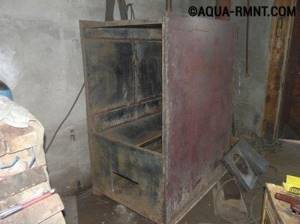
The body of the pyrolysis boiler should be made of sufficiently strong steel that can withstand high temperatures. The metal thickness must be at least 3 mm
A thorough study of the diagrams, drawings and structure of the pyrolysis boiler allows you to begin its actual manufacture. Using a grinder, the necessary elements are cut out. Then a welding machine is used. The assembly of the pyrolysis boiler is presented in great detail in the following video:
In addition, a number of recommendations should be followed:
- The fuel loading hole for home-made models is usually placed slightly higher than that of conventional solid fuel boilers.
- It is imperative to install a limiter that will allow you to control the amount of air entering the fuel chamber, as well as add firewood or briquettes in a timely manner.
- To make a limiter, you can use a pipe with a diameter of about 70 mm, slightly longer than the body of the device.
- A steel disk should be welded to the bottom of the limiter, forming a gap of about 40 mm with the pipe walls.
- To install the limiter, a corresponding hole must be made in the boiler lid.
- The loading hole for firewood should be made rectangular. This hole is closed with a door with a special steel plate that ensures a secure fit.
- Below you need to make a hole to remove ash.
- The pipe through which the coolant moves inside the boiler must be bent to maximize heat transfer.
- The amount of coolant entering the boiler can be adjusted using a valve installed outside.
If after the first start-up of the boiler there is no carbon monoxide in the combustion products, it means that the design is made accurately and functions correctly. In the future, you should regularly monitor the condition of the boiler welds and promptly clean it of accumulated ash and soot.
Please note that a very successful combination is the use of a pyrolysis boiler not with traditional water heating, but with air heating systems. In this case, the air is transmitted through pipes and returned to the system along the floor
Such a system will not freeze during a sudden cold snap; if the home owners leave, there is no need to drain the coolant.
Conditions for scale formation. Steam boiler blowdown
Conditions for scale formation.
Blowing out steam boilers As water evaporates, the concentration of salts in it continuously increases. If salts are not removed from the boiler, then at a certain concentration in water they fall out of solution and are deposited on the heating surface in the form of scale. When heated to 80 – 100 °C, Ca and Mg bicarbonates dissolved in water (Ca(HCO3)g, Mg(HC03)2) decompose, forming sludge, and are deposited in the lower points of the boiler (lower drums and collector).
Scale concentrates on the most heat-stressed surfaces of the screen and boiler pipes and boiler drums. Scale conducts heat 40 times (from 20 to 100 in different boilers) worse than iron, so when working with scale, fuel consumption increases and the reliability of the boiler heating surfaces decreases. (Soot conducts heat 400 times worse).
Dependence of excessive fuel consumption on scale thickness
Scale thickness, mm
Average value of excessive fuel consumption, %
Due to the low thermal conductivity of scale, the metal of boiler and screen pipes is poorly cooled and is subject to severe overheating, as a result of which its strength decreases. This leads to the appearance of bulges, cracks, rupture of pipes and even explosion of drums and boilers. On modern water-tube boilers, operation of the boiler under the condition of scale formation is unacceptable. Boilers must operate in a scale-free mode. Blowing steam boilers To maintain the permissible salt content of boiler water, boilers are blown. Blowing is the removal of foreign impurities (salts, sludge, alkalis, suspended solids, etc.) from the boiler along with boiler water while simultaneously replacing the blown feed water. Blowing can be periodic or continuous. Periodic blowing is carried out at certain intervals and is intended to remove sludge from the lower points of the boiler: drum, screen collectors, etc. It is carried out briefly, but with a large discharge of boiler water, which entrains and carries out the sludge. Blowing is carried out into an expander designed to cool the water before discharging it into the sewer. Continuous blowing ensures the constant removal of dissolved salts of constant hardness to maintain their permissible concentration. Continuous blowing is usually carried out from the upper drum and is regulated by a needle valve. The water is discharged into the expander (separator), where steam is separated from the water. Both steam and water are used to heat raw or chemically purified water (their heat is used). The timing and duration of blowdowns are established by instructions or by the head of the boiler room (according to the instructions of the laboratory).
If you are not a specialist and don’t have time to deal with website development, you can always contact a qualified company that will be ready to create a website for you.
Whatever mood you and your friends are in, you can always buy a gift for any holiday
In our store you can always buy diapers and make your child happy
Checking traction

The anemometer device determines the draft force when smoke moves at a speed of 1 m/s or more. In the off-season, the device shows unreliable results due to the slight difference in the temperatures of the external and internal environments and the low flow speed. The advanced gas analyzer measures tractive effort in pascals (Pa) and is accurate but expensive. A reading of 10–20 Pa is considered sufficient.
The color of the fire in the firebox shows the traction force:
- yellow and golden tongues indicate normal flow speed;
- white flame and hum indicate that the draft is excessive;
- dark shades indicate insufficient speed.
The presence of gravity is determined in simple ways. A piece of thin paper is brought to the opening of the chimney. Its deviation indicates the movement of flows. A burning match works in a similar way, the flame of which should deviate from the vertical in the direction of the draft. Smoke in the boiler room indicates the reverse movement of smoke in the chimney.
Installing the deflector

Homemade and purchased models are assembled into a finished product below, before installation on the pipe. The aerodynamic structure is bolted to a round metal asbestos pipe; usually, 3 holes are made in the pipe for this purpose. If there is slight play, a clamp is used.
An adapter is used to mount the deflector in a brick pipe of rectangular or square cross-section. The device is tested after installation. The spark arrestor is made independently from a thin metal mesh or stainless steel sheet.
The diameter of the structure must be larger than the outlet of the pipe so that the deflector does not fall inside the channel and block the smoke exit. Rotary draft controls do not work well in cold regions with heavy snowfall. Icing interferes with the operation of the device. The devices are installed in accordance with technical standards and requirements.



